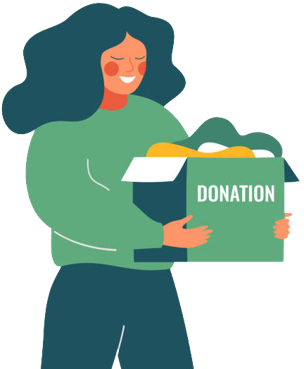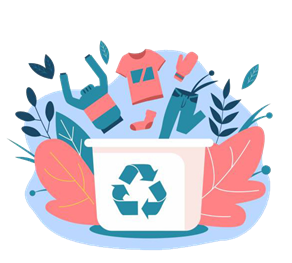 Make the most of your clothes
Make the most of your clothes

Don`t throw Them away!
Around 5,000 tonnes of shoes and clothes end up as waste in Cumbria - that`s enough to fill more than 3 Olympic swimming pools. Making clothes uses large amounts of water, causes pollution and is responsible for around 4% of the world`s CO2 emissions. And yet 30% of clothes in a typical wardrobe haven`t even been worn in the past year. So being smart with your clothing choices has big benefits for the environment - and can save you money too! Find out how you can make a difference, reduce the amount of clothing going to waste, and keep your clothes looking good for longer.
 Reducing waste starts with the clothes you buy in the first place. So buy clothes you like, will wear regularly and that will last. Before buying, try asking yourself "am I likely to wear this at least 30 times?" If not, perhaps a clothing rental service might be a good option, especially for big occasions.
Reducing waste starts with the clothes you buy in the first place. So buy clothes you like, will wear regularly and that will last. Before buying, try asking yourself "am I likely to wear this at least 30 times?" If not, perhaps a clothing rental service might be a good option, especially for big occasions.
Buying pre-loved clothing rather than new is another great way to keep clothes in use for longer and means
fewer resources are consumed making brand new clothes. There are vintage and used clothing shops where you can both buy and sell previously-worn clothing. If you buy from a charity shop you are also supporting your chosen good causes. To find a charity shop near you just visit the reuse map. But if you can`t easily get to a shop many larger charities now sell clothes online too.
There are also Apps where you can buy and sell pre-loved clothing. Depop, Vinted and Nuw are just a few examples These are booming in popularity and offer the convenience of buying and selling from the comfort of home. In addition, you can have the satisfaction of finding something unique or bagging yourself a bargain. Look out too for community clothes swap events. Or you could simply swap items with friends and family.
 Taking care of your clothes keeps them looking good for longer. Take a look at the care labels to see which wash cycle and laundry products to use, and how to dry them. The Get to know care labels guide explains what the care symbols mean. Washing and tumble-drying less frequently reduces wear - and saves on energy costs and your time too! And this Care and Repair page has tips on removing stubborn stains.
Taking care of your clothes keeps them looking good for longer. Take a look at the care labels to see which wash cycle and laundry products to use, and how to dry them. The Get to know care labels guide explains what the care symbols mean. Washing and tumble-drying less frequently reduces wear - and saves on energy costs and your time too! And this Care and Repair page has tips on removing stubborn stains.
 More and more people have found satisfaction from repairing and altering their clothes and making them more individual and personal. Missing buttons, broken zips and minor tears can be fixed. Clothes that don`t quite fit can be adjusted.
More and more people have found satisfaction from repairing and altering their clothes and making them more individual and personal. Missing buttons, broken zips and minor tears can be fixed. Clothes that don`t quite fit can be adjusted.
Altering, accessorising and combining clothes in new ways can refresh your
wardrobe at almost no expense. If you`ve not tried it before, online tutorials are a great way to get started.
Look out for repair cafes where you can get stuff repaired for free as well as finding out how to do it yourself. But if you don`t have time there are plenty of local clothing alteration shops, shoe repairers, and dry cleaners who could do it for you.
 There are lots of options to avoid unwanted clothes going to waste, whether it`s a former favourite you`ve fallen out of love with, something the kids have outgrown or clothes that have been forgotten. Much surplus clothing is still wearable, so swap it, donate to charity, sell online, give to friends and family, or give away via platforms such as Freegle and Olio. More stores now have clothing takeback schemes, so if you do need to buy something new you can take back your old clothes at the same time.
There are lots of options to avoid unwanted clothes going to waste, whether it`s a former favourite you`ve fallen out of love with, something the kids have outgrown or clothes that have been forgotten. Much surplus clothing is still wearable, so swap it, donate to charity, sell online, give to friends and family, or give away via platforms such as Freegle and Olio. More stores now have clothing takeback schemes, so if you do need to buy something new you can take back your old clothes at the same time.
Charity shops, textile banks, and doorstep charity collections welcome donations of good quality shoes and clothes and shoes to sell. Some also accept worn-out and damaged items for recycling - but please contact them first to check if they do. Keep donated items clean and dry and remember not to leave then in a shop doorway or at the side of a textile bank. If you can`t get to a shop, some charities will send a pre- paid bag for you to return with your donations.
Each of the county council`s 14 Household Waste Recycling Centre`s has textile banks which accept clean clothing, shoes, and linen. Even worn-out items can often be recycled for products such as insulation.
For a summary of where you can take used clothes and textiles for reuse and recycling see Recycling Textiles.
See below to check what you can take to Household Waste Recycling Centres, Charity Shops, and Textiles Banks.
Household Waste Recycling Centres
What can I put in textiles collections at Household Waste Recycling Centres?
| ✔ Yes please | ✘ No thanks |
|
|
At Charity Shops, Textile Banks and Bagged Collections
What can I give to Charity Shops, Textile Banks and doorstep Bagged Collections?
| ✔ Yes please | ? Please check | ✘ No thanks |
|
|
|
Cumberland Council: 0300 373 3730
Westmorland & Furness Council: 0300 373 3300
